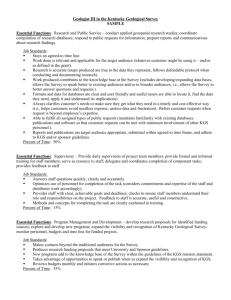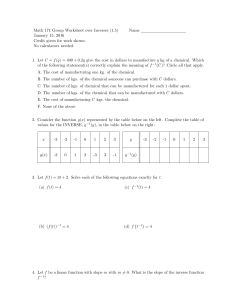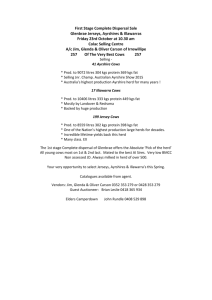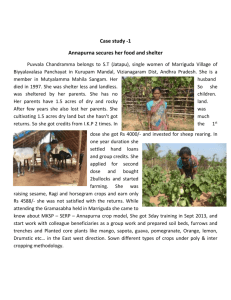Document 12908587
advertisement
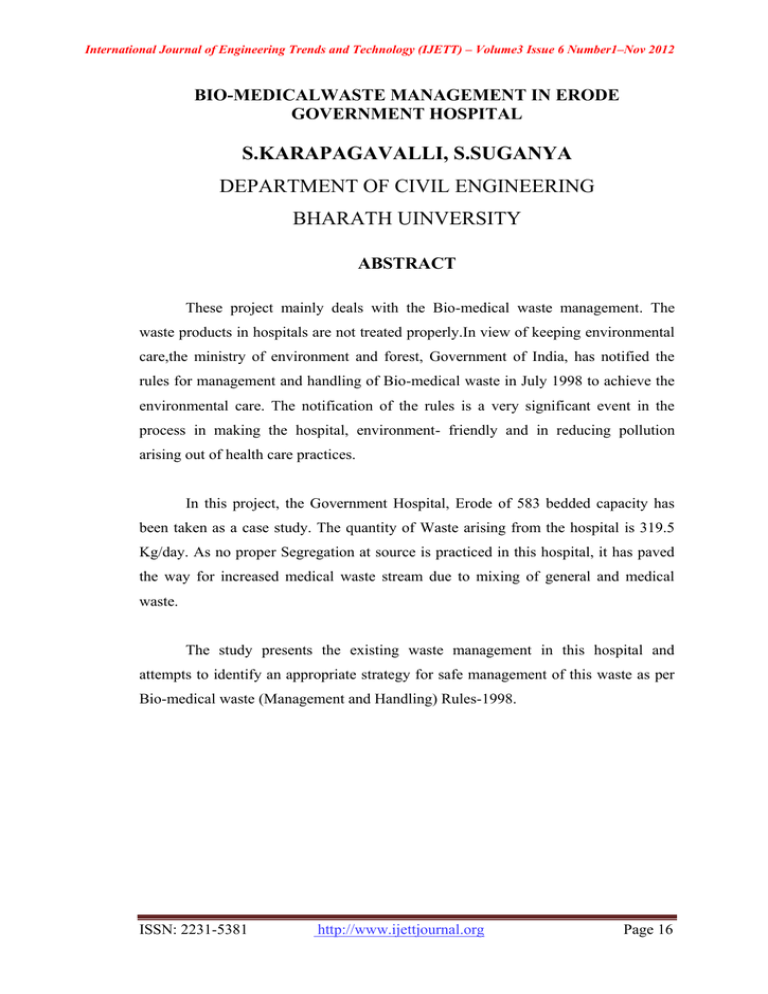
International Journal of Engineering Trends and Technology (IJETT) – Volume3 Issue 6 Number1–Nov 2012 BIO-MEDICALWASTE MANAGEMENT IN ERODE GOVERNMENT HOSPITAL S.KARAPAGAVALLI, S.SUGANYA DEPARTMENT OF CIVIL ENGINEERING BHARATH UINVERSITY ABSTRACT These project mainly deals with the Bio-medical waste management. The waste products in hospitals are not treated properly.In view of keeping environmental care,the ministry of environment and forest, Government of India, has notified the rules for management and handling of Bio-medical waste in July 1998 to achieve the environmental care. The notification of the rules is a very significant event in the process in making the hospital, environment- friendly and in reducing pollution arising out of health care practices. In this project, the Government Hospital, Erode of 583 bedded capacity has been taken as a case study. The quantity of Waste arising from the hospital is 319.5 Kg/day. As no proper Segregation at source is practiced in this hospital, it has paved the way for increased medical waste stream due to mixing of general and medical waste. The study presents the existing waste management in this hospital and attempts to identify an appropriate strategy for safe management of this waste as per Bio-medical waste (Management and Handling) Rules-1998. ISSN: 2231-5381 http://www.ijettjournal.org Page 16 International Journal of Engineering Trends and Technology (IJETT) – Volume3 Issue 6 Number1–Nov 2012 1. INTRODUCTION The rapid urbanization and urban development has lead to overcrowding of town and cities. The stress and strain of modern life has caused set backs/ effects of both general and serious nature. To restore the community health there has been a spurt in growth of hospitals in both private and government sector. They have been made much remarkable advancement in the field of medical practice. Sophisticated instruments are being used for diagnosis and treatment. This advancement results in increase in per capita per patient generation of Bio-medical waste. Though hospitals are meant to restore human health, the disposal of hospital waste is a matter of concern. Bio-medical waste has recently emerged as an issue of major concern not only in hospitals, nursing home but also to environmental law enforcement agencies,media and the general public. All types of health care facilities, laboratory, clinics, nursing homes and medical, dental and veterinary hospitals generate a waste stream. Some of these wastes are threat to human being and environment. The greatest risk is from the infection and sharp components. In addition to its infectivity its high toxicity and radioactivity has increased public concern about treatment, transportation and ultimate disposal. Awareness about the procedure for proper management and the legal requirements for Bio-medical waste disposal is rather poor amongst the medical fraternity. Keeping this in view the Union Ministry of Environment and forest notified “Bio-medical waste (Management and Handling) rules, 1998”, under the provision of environment protection act 1986. Under these rules every health care institute big or small will have to made arrangement to ensure that such waste is handled and managed without adverse health effect to human beings and the environment. ISSN: 2231-5381 http://www.ijettjournal.org Page 17 International Journal of Engineering Trends and Technology (IJETT) – Volume3 Issue 6 Number1–Nov 2012 2. MATERIALS AND METHODS 2.1.GENERAL Bio-medical wastes that are highly hazardous should be handled with great care. Management of these wastes may cause adversary effects to the handling workers. So to avoid this problems they should have enough precautions before handling this wastes. The Government hospital Erode which we have chosen for case study is located in heart of city with large beds of capacity 583 Nos. . 2.2 MATERIALS AND METHODS 2.2.1 Method of sample collection The various types of bio- medical waste generated in this Government hospital were collected with the help of doctors and staff members in that hospital. First a survey was done on the type of waste generated from each ward,type of disposal ,time of disposal,quantity of disposal etc. Absolute quantity of waste produced daily were collected, measured and weighed. 2.2.2 Analysis of Bio-medical and General waste Each ward is provided with two containers, one for general and other for biomedical waste. The quantity generated were measured with help of sanitary assistants. The details of waste arising from different wards are shown in the Table 3.1and Table 2.2.The composition of general waste are also shown in the table 2.3. From the table 2.2, Total waste generated in this hospital is 319.5 Kg/day.It includes 157.5 Kg of medical waste and 162 Kg general waste. The waste generated in this government hospital is not subjected to any treatment ISSN: 2231-5381 http://www.ijettjournal.org Page 18 International Journal of Engineering Trends and Technology (IJETT) – Volume3 Issue 6 Number1–Nov 2012 TABLE 2.1 QUANTITY OF GENERAL AND BIO MEDICAL WASTE ARISING FROM DIFFERENT WARDS AND UNITS (Kg/ day) SL. NO SOURCE Kitchen 1. 2. GENERAL WASTE Blood Bank Operation Theatre - ISSN: 2231-5381 SHARPS Vegetable &food waste -10 kg - 3. INFECTIOUS WASTE - - Disposable Cotton1/4roll, siringe,lancets, Blood glass slides-1kg transformation set,dispossable Blood bag,bilot bottle,coverslip, Serum bottle -5kg Needles90nos, blades50nos, Ampules few Nos. -1kg http://www.ijettjournal.org Gauze piece ,pads, Catheters,cover s, Gloves -5kg Page 19 INFECTIOUS/ POTENTIALL CHEMICAL Y WASTE INFECTIOUS PLASTICS - - - Chemical I.V Bottles, powder and I.V.sets-30 nos liquid -5 kg -1.5kg International Journal of Engineering Trends and Technology (IJETT) – Volume3 Issue 6 Number1–Nov 2012 4. Laboratory - 5. Men Medical I II 6. Labour Septic ward Normal Complicated 7. Men surgical I II III 8. 9. Paper waste,plastic &disposable cups, Food &sweeping waste -20 kgs Fruit ,food &paper waste ,sweeping &card board waste -20 kgs Fruit ,food &paper waste ,sweeping &card board waste Plastic waste -20 kgs Fruit ,food &paper waste ,sweeping -15 kgs Female Surgical I II III Men post operative ward ISSN: 2231-5381 Syringes 50 Bio-chemical Nos., sample, blood Glass slides &urine sample -1 kg 50 Nos. -4kg Injection-50, Blood ampules 100 bags,gauze nos piece, dressing -1.5kgs waste, disposable syringes -2.5 kgs Needles,bladde Cottons s dressing waste, -1.5 kgs gauze pieces,pads -2 kgs Disposable Dressing waste syringe and ,cotton ,blood Ampules bags ,needles -3 kgs Blades, ampules, Needles -2 kgs Food & ampules, sweeping waste Needles http://www.ijettjournal.org Dressing waste ,cotton ,blood bags,gauze piece,dissposab le syringes 3kgs Cottons dressing waste, Page 20 - Chemical powder -2 kgs - I.V.Bottles& I.V Sets,blood transformation sets -6 kgs Placenta,blood I.V. Bottles waste I.V.Sets -20 kgs -6 kgs - - - I.V.Bottles& I.V Sets,blood transformation sets -7 kgs I.V.Bottles& I.V Sets,blood transformation sets -8 kgs I.V. Bottles I.V.Sets International Journal of Engineering Trends and Technology (IJETT) – Volume3 Issue 6 Number1–Nov 2012 -2kgs 10. 11. 12. 13. 14. 15. Female ward -1 kgs operative Fruit ,food ampules, &paper waste Needles ,sweeping -1/2 kgs &card board waste -2 kgs Men medical – I ampules, Fruit ,food Needles,blood &paper waste transformation ,sweeping sets &card board -1.5 kgs waste -15 kgs Female medical – II Fruit ,food Ampules, &paper waste Needles ,sweeping -1.5 kgs &card board waste -20 kgs Children ward Card board Ampules, waste, food Needles waste, plastic -few Nos. waste -6 kgs Family planning ward Ampules, Needles -few Nos. ICU Paper Needles, waste,plastic Disposable ISSN: 2231-5381 post http://www.ijettjournal.org gauze pieces,pads,glo ves -2kgs Pads gloves,bottles,u ro bags -3.5 kgs -2 kgs - - Cotton Chemical ,bandages cloth powder -1/2 kgs -1 kgs I.V. Bottles, I.V.Sets -5 kgs Cotton ,blood Chemical bags ,catheters powder -2.5 kgs -1 kgs I.V. Bottles, I.V.Sets -4 kgs I.V. Bottles I.V.Sets, cottons -3 kgs Cottons dressing waste -1 kgs - Page 21 - - - - - I.V.Bottles& I.V Sets,blood International Journal of Engineering Trends and Technology (IJETT) – Volume3 Issue 6 Number1–Nov 2012 16. 17. 18. 19. 20. 21. Casuality ward New born ward Isolation ward T.B ward I II Eye ward Lapracy ward ISSN: 2231-5381 waste -2 kgs syringes -0.5 kgs Fruit ,food &paper waste ,sweeping &card board waste -5 kgs - Ampules, Needles -0.5 kgs Ampules, Needles,bottles -few Nos. Fruit ,food Ampules, &paper waste Needles ,sweeping -1 kgs &card board waste 8 kgs Paper Ampules, waste,plastic Needles &disposable -1.5 kgs cups, Food &sweeping waste -12 kgs transformation sets -5 kgs Bandages, gauze pieces, cotton -3.5 kgs Cloths &cotton waste -2 kgs Cottons and dressing waste - 0.5 kgs - - - - - Cottons,I.V.Set Chemical s &I.V Bottles powder - 2 kgs -1.5 kgs - Needles, glass Dressing waste pieces few Nos. cottonwaste, cloths -2 Kgs Fruit ,food Needles, glass Gauze Chemical &paper waste, pieces few nos pieces,cottons , powder sweeping I.V. Bottles -1.5 Kgs http://www.ijettjournal.org I.V. Bottles I.V.Sets -3kgs Page 22 - - International Journal of Engineering Trends and Technology (IJETT) – Volume3 Issue 6 Number1–Nov 2012 &card waste -5 kgs 22. 23. O.P.Ward board - I.V.Sets - 4 Kgs Needles Cotton,bandage s -5 Kgs x-rays Total waste ISSN: 2231-5381 - - - 162 Kgs 16 Kgs 59 Kgs http://www.ijettjournal.org Page 23 - - Chemical powder, radio active waste - 3 kgs 31.5 Kgs 51 Kgs International Journal of Engineering Trends and Technology (IJETT) – Volume3 Issue 6 Number1–Nov 2012 Table 2.2 QUANTITY OF BIO-MEDICAL WASTE MANAGMENT TYPE OF WASTE ( Kg) Sl.No 1. SOURCE Kitchen Blood bank 3. Operation theatre 4. Laboratory 5. Men medical 6. 7. Labour septic -complicated -normal Men surgical ISSN: 2231-5381 GENERAL WASTE BIO- MEDICAL WASTE 10 - 10 6 6 12.5 12.5 5 5 20 12 32 20 29.5 49.5 20 10 30 - 2. - I II I II III TOTAL WASTE (Kg) http://www.ijettjournal.org Page 24 EXISTING DISPOSAL METHOD Collected by Municipality International Journal of Engineering Trends and Technology (IJETT) – Volume3 Issue 6 Number1–Nov 2012 Men surgical 8. I II III 15 13 28 9. Men post operative ward 2 5 7 10. Female post operative ward Men Medical – I II 2 4 6 15 8 23 20 9 29 11. 12. 13. 14. 15. 16. 17. 18. 19. 20. Men Medical – I II 6 3 9 Children ward Family planning ward - 1 1 ICU 2 8.5 10.5 Casualty ward 5 4 9 New born ward - 2 2 Isolation ward 8 4.5 12.5 T.B ward – I II Eye ward 12 5 17 - 2 2 ISSN: 2231-5381 http://www.ijettjournal.org Page 25 Collected by Municipality International Journal of Engineering Trends and Technology (IJETT) – Volume3 Issue 6 Number1–Nov 2012 21. 22. 23. Lapracy ward 5 5.5 10.5 OP ward - 5 5 X-ray unit - 3 3 162 Kg 157.5 Kg 319.5 Kg Total waste 44 ISSN: 2231-5381 http://www.ijettjournal.org Page 26 Collected by Municipality International Journal of Engineering Trends and Technology (IJETT) – Volume3 Issue 6 Number1–Nov 2012 3.1 RESULTS AND DISCUSSION Table 3.1 and 3.2 gives to the quantity of general and bio medical waste arising from different wards and units of the hospital. Table 4.1 gives the proposed color coding for the bins and method for treatment and disposal of general and biomedical waste arising from the hospital. From this it is seen that the waste arising from kitchen is vegetable and food waste of about 10 Kgs with no trace of medical waste. They are collected in plastic bin of green colour. Wastes arising from blood bank are of medical waste and consist of sharps and infectious waste. Sharp waste is around 1Kg per day, which includes disposable syringes, glass slides, etc. Infectious waste such as disposable blood bag, blood transformation set, lancet, cotton, serum bottle of around 5 Kgs. Both the wastes are collected in one bin and disposed through incineration. Wastes from operation theatres are infectious sharp, chemical and potentially infectious plastics. Quantity of waste arising from this unit is about 12.5 Kg/day. Only one bin is used for collecting the wastes. The quantity of waste arising from men medical wards is about 30 Kgs including general and medical waste. Where food wastes is maximum compared to other waste. Quantity of waste from Labor septic ward includes general waste of about 20 kgs and medical waste of about 30 Kgs. I.V. bottles and I.V sets arising from this ward are collected separately. Blood waste and placenta is around 20 Kgs in medical waste. It is found that about 60 Kgs of waste arise from male and female surgical ward where general waste is about 35 Kgs and medical waste includes blades, Ampules, needles, cotton, blood bags. Each ward contains 2 bins and the general wastes are collected in one bin and medical wastes are collected in other bin. The general wastes are disposed through landfills and the bio-medical wastes are disposed through incineration. Waste arising from men postoperation ward includes general waste of about 2 kgs of food waste and sweeping waste and bio medical waste of about 5 Kgs including cotton wastes, pads, uro bags and gloves, I.V bottles and I.V. sets are ISSN: 2231-5381 http://www.ijettjournal.org Page 27 International Journal of Engineering Trends and Technology (IJETT) – Volume3 Issue 6 Number1–Nov 2012 collected separately. The general wastes are disposed through landfills and medical waste through incinerator. Waste arising from female post-operative ward contains total waste of about 6 kgs. In that general waste comprises about 2 Kgs and medical waste of about 4 Kgs. They are disposed by the method suggested in post-operative ward The waste arising from men and female medical wards are of 52 Kgs out of this 35 Kgs are of general waste and 17 Kgs are of bio medical waste general waste includes food waste, paper, card board waste, sweeping waste etc. The medical waste consists of sharp waste like needles, Ampules, blood transformation sets and infectious wastes like cotton, bandages, cloths, and chemical powders. The I.V bottles and I.V sets are collected separately and they are disposed. In children ward the medical waste of 3 Kgs and general waste of 6 Kgs are generated. The medical waste includes cotton, bottles I.V sets blood transformations and general wastes like food waste, fruit waste, plastic and sweeping waste. In family planning ward no trace of general waste were found and medical waste accounts of about 1 Kg. The quantity of waste arising from the ICU ward around 11 Kgs includes both general and medical waste. I.V bottles and I.V sets are also collected separately in this ward.other waste includes needle syringes blood bags, gauze piece, paper and plastic waste, cotton waste. The general waste are disposed by landfills and the bio medical waste are disposed by incineration. In causality ward, general waste generated is about 5 Kgs and medical waste about 4 Kgs . Medical waste includes needles, ampules, bandages, gauze pieces and cottons. The waste from new born ward includes cloth, cotton wastes, medicine bottles which comes around 2 Kgs. Waste from isolation ward comprises both general and medical waste. General waste is about 8 Kgs, sharps around 1Kg, infectious waste such as cotton and dressing waste of about ½ Kg, I.V bottles and sets of about 3 Kgs. The total waste from T.B wards is about 17 Kgs. In this general waste is about 12 Kgs and medical wasting about 5 Kgs. The medical waste includes needle, ampules, bottle, cotton, I.V bottles and sets. ISSN: 2231-5381 http://www.ijettjournal.org Page 28 International Journal of Engineering Trends and Technology (IJETT) – Volume3 Issue 6 Number1–Nov 2012 No trace of general waste is found in Eye ward and medical waste comprises about 2.5 Kgs, which includes needles, glass pieces, dressing waste cotton clothes etc. Waste from Lapracy ward is around 11 Kgs. In that medical waste is about 6 Kgs and general waste likes paper waste and food waste is about 5 Kgs. From the above details the total quantity of wastes is about 319.5 Kgs. Of this total waste produced, medical waste is about 48 % and general waste comprises about 52%. All these wastes are collected in separate bins provided in each ward. General and bio-medical wastes are collected separately. But while transporting, they are mixed together and dumped in a separate place near mortuary inside the hospital. TABLE 3.1 PROPOSED CONTAINER COLOUR CODING FOR MEDICAL WASTE AND GENERAL WASTE Quantity per day Type of waste Colour coding (Kg/day) General waste 162 Sharps 16 Infectious waste Chemical and liquid waste Infectious/ Potentially infectious plastics 59 31.5 51 Green White/ Translucent puncture proof bag/ container Yellow Black Red Green colour bags and containers are to be used to store the general wastes. Sharps may damage the bags, so puncture proof containers are to be used . Infectious wastes are to be collected in Yellow bags . Black containers are suggested for collection of chemical waste and Red colour containers for infectious / potentially infectious plastic. If all the measures suggested by us are adopted , the effect of waste and its hazardous can be minimized. ISSN: 2231-5381 http://www.ijettjournal.org Page 29 International Journal of Engineering Trends and Technology (IJETT) – Volume3 Issue 6 Number1–Nov 2012 CONCLUSION Since environmental pollution has become a major concern with respect to the future of life on our planet. It is legal duty of the management of the health care institution to ensure that bio-medical waste are managed properly without putting extra burden on health care staff in their duties and causing any adverse impacts on human health or environment. Based on the results the following suggestions were listed as follows: The doctors and nurses should take the responsibility to classify correctly the bio-medical waste at the source, which allows subsequent waste segregation to occur properly. Simplified colour coding system of hospital waste management can be introduced instead of introducing complex system with too many colour coded bags or bins simplified colour coding system as 1. Yellow bag/bin that needs to incinerate or deep burial containing human microbiological waste, sharp waste, discarded medicine, Cytotoxic drugs, and soiled waste. 2. Red bags/ bins that needs to autoclave, chemical Disinfection or microwave containing plastic waste, disposable items like tubes, catheter, blood or uro bags, gloves etc. 3. Black bags/ bins that are to be send for secured Landfilling or burial, containing chemical solid waste and incinerated ash. Labeling is essential in the correct identification and safe management of medical waste. All labeling and sign posting should be clean and use the international symbols and colour coding as given in schedule. Sharp management should be practiced by providing puncture resistant containers or mutilate sharps at the point of generation using needle destroyers. It is firmly believed that collective community effort rather than individual attempts would make handling and disposal of bio- medical waste economically and operationally viable. ISSN: 2231-5381 http://www.ijettjournal.org Page 30 International Journal of Engineering Trends and Technology (IJETT) – Volume3 Issue 6 Number1–Nov 2012 REFERENCE 1. Srinivasa Chary.V1999 “Medical waste management practices in urban India and strategies for safe Disposal”Bio-medical waste management proceedings. 2. Ram Srivastan.S, 1999 “Public-private partnership for infectious Medical waste management in India, Bio-medical waste management proceedings. 3. Dr. Murali. R 1999 “Hospital waste disposal disposal in Tamil Nadu Government Hospitals”,Bio-medical waste management proceedings. 4. Sudheer. S. Basargekar, 1999 “Bio-medical waste treatment Technology”, Biomedical waste management proceedings. 5. Dr. Sateesh V.L., 1999 “Bio-medical waste management-challenges for health care managers”, Bio-medical waste management proceedings. 6. Ms.Bineesha & Dr. Mahendra. B. 1995 “Bio-medical waste management: comprehensive approach & feasibility options”, Bio-medical waste management proceedings. 7. Dr. Jane E.Rubienstern, 1999 “Alternate Technologies for handling & treating of waste generated by health care sector”, Bio-medical waste management proceedings. 8. Ms. Archana dange, 1999 “segregation and minimisation of Bio-medical wastes as per the Bio-medical waste management proceedings. 9. Dr. Kalpana Balakrishna, 1999 “Strategies for sustainable initiatives in Biomedical waste management.” 10. Trunberg, Waynelk (Wayne) lawrence 1996 “Bio-Hazardous waste: Risk Assement, policy & Management. 11. Sekar. T & Zakariya. K.M., “Efficient and safe disposal of Bio-medical waste for an urban locality-a case study”. 12. Sathya Narayanan. S. 1999 “The global war on waste (WOW)is to be fought in local battles”, Bio-medical waste management proceedings. ISSN: 2231-5381 http://www.ijettjournal.org Page 31
